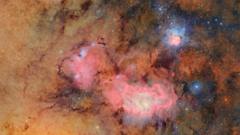In April, astronomers made headlines with a tantalizing claim: they suggested that they had possibly discovered signs of life on K2-18b, an exoplanet located over 120 light-years away. This revelation sparked global interest and intense scrutiny from the scientific community. However, in the following month, three independent studies emerged, collectively dismissing the evidence for biological activity on K2-18b.
“Once we revisited the data, the original claim just absolutely vanishes,” remarked Luis Welbanks, a researcher at Arizona State University and co-author of one of the recent studies. The ongoing debate primarily revolves around the difficulties of observing such distant celestial bodies rather than any definitive proof of extraterrestrial beings. Unlike nearby planets like Jupiter, which reflect sufficient sunlight and can be visually detected, K2-18b's great distance renders it completely invisible to conventional telescopes.
To extract information from such far-off worlds, astronomers have creatively employed a variety of advanced techniques. For example, measuring the gravitational influence of exoplanets on their host stars or observing transits, where a planet passes in front of a star, allows researchers to gather crucial data. A notable milestone occurred in 2010 when scientists studied GJ 1214b, a planet 48 light-years distant, and identified atmospheric characteristics indicative of water vapor.
The game changed in 2022 when researchers began utilizing the James Webb Space Telescope, significantly enhancing their ability to detect faint starlight patterns and decode complex atmospheric compositions in distant planetary systems. Despite the progress, the recent findings regarding K2-18b raise pressing questions about the reliability of the instruments and methods used to infer the presence of life beyond Earth. As the scientific community continues to unravel the mysteries of our universe, the hunt for extraterrestrial life remains an unfulfilled yet hopeful endeavor.























